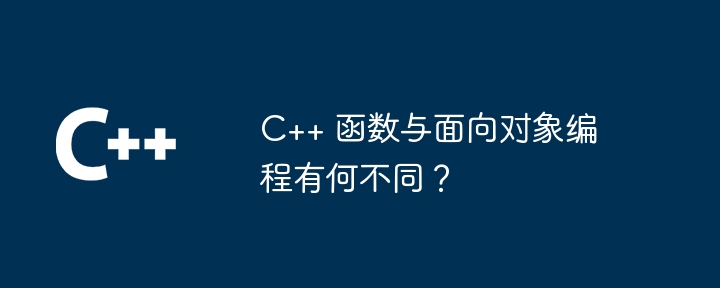How do C++ functions differ from object-oriented programming?
Apr 11, 2024 pm 09:12 PMFunctions and Object-Oriented Programming (OOP) provide different programming mechanisms in C: Functions: independent blocks of code focused on performing a specific task and containing no data. OOP: Based on objects, classes and inheritance, data and behavior are encapsulated in objects. In practical cases, the function method for calculating the area of ??a square is simple and direct, while the OOP method encapsulates data and behavior and is more suitable for managing object interaction. Choosing the appropriate approach depends on the scenario: Functions are good for independent tasks, OOP is good for managing complex object interactions.


Hot AI Tools

Undress AI Tool
Undress images for free

Undresser.AI Undress
AI-powered app for creating realistic nude photos

AI Clothes Remover
Online AI tool for removing clothes from photos.

Clothoff.io
AI clothes remover

Video Face Swap
Swap faces in any video effortlessly with our completely free AI face swap tool!

Hot Article

Hot Tools

Notepad++7.3.1
Easy-to-use and free code editor

SublimeText3 Chinese version
Chinese version, very easy to use

Zend Studio 13.0.1
Powerful PHP integrated development environment

Dreamweaver CS6
Visual web development tools

SublimeText3 Mac version
God-level code editing software (SublimeText3)

Hot Topics
 How to reduce the use of global variables in C?
May 23, 2025 pm 09:03 PM
How to reduce the use of global variables in C?
May 23, 2025 pm 09:03 PM
Reducing the use of global variables in C can be achieved by: 1. Using encapsulation and singleton patterns to hide data and limit instances; 2. Using dependency injection to pass dependencies; 3. Using local static variables to replace global shared data; 4. Reduce the dependence of global variables through namespace and modular organization of code.
 c: What does it mean? Data bit c Median domain definition colon usage
May 23, 2025 pm 08:48 PM
c: What does it mean? Data bit c Median domain definition colon usage
May 23, 2025 pm 08:48 PM
In C, the bit field is a structure member that specifies the number of bits, used to save memory and directly manipulate hardware. Example: structMyStruct{inta:2;intb:5;intc:1;}. The advantage of bit domains is memory savings, but there are cross-platform issues, access restrictions and assignments that require caution. Example of usage: structStateMachine{unsignedintpower:1;unsignedintmode:2;unsignedinterror:1;}. Performance recommendations include arranging bit fields by size, avoiding overuse and adequate testing.
 Usage of ? in c Analysis of three-item operator instance in c
May 23, 2025 pm 09:09 PM
Usage of ? in c Analysis of three-item operator instance in c
May 23, 2025 pm 09:09 PM
The syntax of the trigonometric operator in C is condition?expression1:expression2, which is used to select and execute different expressions according to the condition. 1) Basic usage example: intmax=(x>y)?x:y, used to select the larger value in x and y. 2) Example of nested usage: intresult=(a>0&&b>0)?a b:(a==0||b==0)?a*b:a-b, used to perform different operations according to different conditions. 3) Error handling example: std::stringerrorMessage=(errorCode==0)?"Successful&quo
 Usage of c Typical application scenarios of logical non-operators
May 23, 2025 pm 08:42 PM
Usage of c Typical application scenarios of logical non-operators
May 23, 2025 pm 08:42 PM
The usage of logical non-operator! in C includes: 1) Basic usage: inverse the Boolean value; 2) Conditional judgment: simplify the code, such as checking whether the container is empty; 3) Loop control: processing elements that do not meet the conditions; 4) Function return value processing: determine whether the operation has failed. Pay attention to potential pitfalls such as pointer processing and operator priority when using!, but it can help write more concise and efficient code.
 How to implement the logging system in C?
May 23, 2025 pm 09:18 PM
How to implement the logging system in C?
May 23, 2025 pm 09:18 PM
Implementing an efficient and flexible logging system in C can use the following steps: 1. Define log classes and process log information at different levels; 2. Use policy mode to achieve multi-objective output; 3. Ensure thread safety through mutex locks; 4. Use lock-free queues for performance optimization. This can build a log system that meets the needs of actual application.
 How to Implement Polymorphism in C : A Step-by-Step Tutorial
Jun 14, 2025 am 12:02 AM
How to Implement Polymorphism in C : A Step-by-Step Tutorial
Jun 14, 2025 am 12:02 AM
Implementing polymorphism in C can be achieved through the following steps: 1) use inheritance and virtual functions, 2) define a base class containing virtual functions, 3) rewrite these virtual functions by derived classes, and 4) call these functions using base class pointers or references. Polymorphism allows different types of objects to be treated as objects of the same basis type, thereby improving code flexibility and maintainability.
 C : Is Polymorphism really useful?
Jun 20, 2025 am 12:01 AM
C : Is Polymorphism really useful?
Jun 20, 2025 am 12:01 AM
Yes, polymorphisms in C are very useful. 1) It provides flexibility to allow easy addition of new types; 2) promotes code reuse and reduces duplication; 3) simplifies maintenance, making the code easier to expand and adapt to changes. Despite performance and memory management challenges, its advantages are particularly significant in complex systems.
 How to implement function overloading in C?
May 23, 2025 pm 09:15 PM
How to implement function overloading in C?
May 23, 2025 pm 09:15 PM
Function overloading is implemented in C through different parameter lists. 1. Use different parameter lists to distinguish function versions, such as calculatedArea(radius), calculatedArea(length,width), calculatedArea(base,height,side1,side2). 2. Avoid naming conflicts and excessive overloading, and pay attention to the use of default parameters. 3. Functions cannot be overloaded based on the return value type. 4. Optimization suggestions include simplifying the parameter list, using const references and template functions.






